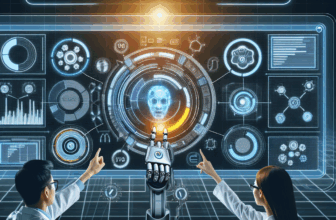Certainly! Below is the structured HTML article titled "Revolutionizing Digital Product Testing: Unlocking the Benefits of AI-Driven Solutions".
<!DOCTYPE html>
<html lang="en">
<head>
<meta charset="UTF-8">
<meta name="viewport" content="width=device-width, initial-scale=1.0">
<title>Revolutionizing Digital Product Testing: Unlocking the Benefits of AI-Driven Solutions</title>
<style>
body { font-family: Arial, sans-serif; line-height: 1.6; }
h1, h2, h3 { color: #2c3e50; }
p { margin-bottom: 1em; }
ul { margin-left: 20px; }
table { width: 100%; border-collapse: collapse; margin-top: 20px; }
th, td { border: 1px solid #ddd; padding: 8px; text-align: left; }
th { background-color: #f2f2f2; }
a { color: #3498db; text-decoration: none; }
a:hover { text-decoration: underline; }
</style>
</head>
<body>
<h1>Revolutionizing Digital Product Testing: Unlocking the Benefits of AI-Driven Solutions</h1>
<h2>Table of Contents</h2>
<ul>
<li><a href="#section1">1. Introduction to Digital Product Testing</a></li>
<li><a href="#section2">2. The Role of AI in Digital Product Testing</a>
<ul>
<li><a href="#subsection2a">2.1 What is AI-Driven Testing?</a></li>
<li><a href="#subsection2b">2.2 Types of AI Used in Testing</a></li>
</ul>
</li>
<li><a href="#section3">3. Benefits of AI-Driven Solutions</a>
<ul>
<li><a href="#subsection3a">3.1 Enhanced Accuracy</a></li>
<li><a href="#subsection3b">3.2 Increased Efficiency</a></li>
<li><a href="#subsection3c">3.3 Cost Reduction</a></li>
<li><a href="#subsection3d">3.4 Comprehensive Coverage</a></li>
</ul>
</li>
<li><a href="#section4">4. Integrating AI in Your Testing Strategy</a>
<ul>
<li><a href="#subsection4a">4.1 Assessing Readiness for AI Integration</a></li>
<li><a href="#subsection4b">4.2 Tools and Technologies</a></li>
</ul>
</li>
<li><a href="#section5">5. Case Studies of AI-Driven Testing</a>
<ul>
<li><a href="#subsection5a">5.1 Example 1: A Leading E-commerce Platform</a></li>
<li><a href="#subsection5b">5.2 Example 2: A Major Fintech Application</a></li>
</ul>
</li>
<li><a href="#section6">6. Challenges and Considerations</a>
<ul>
<li><a href="#subsection6a">6.1 Data Quality and Availability</a></li>
<li><a href="#subsection6b">6.2 Technical Challenges</a></li>
<li><a href="#subsection6c">6.3 Ethical Implications</a></li>
</ul>
</li>
<li><a href="#section7">7. Q&A Section</a></li>
<li><a href="#section8">8. Conclusion and Future Trends</a></li>
</ul>
<h2 id="section1">1. Introduction to Digital Product Testing</h2>
<p>Digital product testing is a critical phase in software development that ensures the functionality, usability, and performance of applications before they reach end-users. As organizations move towards agile methodologies and continuous delivery pipelines, the demand for efficient testing processes has surged. Traditional testing methods, often labor-intensive and prone to human error, have become less effective in meeting the speed and quality expectations demanded by modern consumers. This has given rise to AI-driven solutions that can streamline the testing process, improve accuracy, and reduce time-to-market.</p>
<p>The evolution of technology has drastically altered how developers and quality assurance (QA) teams approach testing. Traditional manual testing methods are being supplemented and replaced with automation solutions powered by artificial intelligence. AI not only automates repetitive testing tasks but also enhances decision-making processes based on data analytics and machine learning algorithms. In this context, this article explores the vast potential of AI in transforming digital product testing, revealing its benefits, challenges, and strategies for successful integration.</p>
<h2 id="section2">2. The Role of AI in Digital Product Testing</h2>
<h3 id="subsection2a">2.1 What is AI-Driven Testing?</h3>
<p>AI-driven testing refers to the use of artificial intelligence technologies to optimize, automate, and enhance various testing processes. As software applications grow in complexity, traditional testing methods often struggle to keep up. AI's capabilities, such as natural language processing (NLP), machine learning (ML), and predictive analytics, can be leveraged to streamline this critical phase of software development.</p>
<p>Some of the key characteristics of AI-driven testing include:</p>
<ul>
<li><strong>Test Automation:</strong> AI can automate repetitive tasks, such as regression testing, enabling QA teams to focus on more complex testing scenarios.</li>
<li><strong>Predictive Analytics:</strong> By analyzing historical testing data, AI can predict potential failure points and identify areas where bugs are likely to occur.</li>
<li><strong>Smart Test Design:</strong> AI algorithms can dynamically generate test cases that are more likely to uncover defects based on application behavior and usage patterns.</li>
<li><strong>Continuous Learning:</strong> AI systems improve their accuracy over time as they learn from past testing outcomes, becoming more effective at identifying issues.</li>
</ul>
<h3 id="subsection2b">2.2 Types of AI Used in Testing</h3>
<p>There are several types of AI technologies that can be applied to digital product testing:</p>
<ul>
<li><strong>Machine Learning (ML):</strong> This technology allows systems to learn from data and improve their performance over time without being explicitly programmed. It can be used in test optimization, anomaly detection, and risk assessment.</li>
<li><strong>Natural Language Processing (NLP):</strong> NLP enables machines to understand and interpret human language, making it easier to generate test cases or even understand requirements directly from documentation.</li>
<li><strong>Robotic Process Automation (RPA):</strong> RPA uses bots to automate structured processes. In testing, RPA can be employed to execute scripts automatically, making repetitive tasks seamless.</li>
<li><strong>Predictive Analytics:</strong> By leveraging historical data, predictive analytics can forecast potential defects and guide testing efforts to those areas that require more scrutiny.</li>
</ul>
<h2 id="section3">3. Benefits of AI-Driven Solutions</h2>
<h3 id="subsection3a">3.1 Enhanced Accuracy</h3>
<p>One of the most significant advantages of leveraging AI for digital product testing is the enhanced accuracy it provides. Automated test scripts previously designed by humans are often susceptible to human error. With AI-driven testing, machine learning algorithms can reduce these inaccuracies by continuously learning from test executions and outcomes. They can remember previous failures, identify why they occurred, and modify future test scripts to mitigate similar issues.</p>
<p>Moreover, AI systems can analyze vast data sets to detect patterns that human testers may overlook. For example, an AI tool could identify that a particular combination of user inputs consistently leads to application crashes, allowing developers to address these issues before they affect end-users.</p>
<h3 id="subsection3b">3.2 Increased Efficiency</h3>
<p>The introduction of AI in digital product testing can lead to significant improvements in efficiency. Test automation, powered by AI, allows for rapid execution of test cases, where hundreds or thousands can run concurrently, significantly reducing the time taken for testing cycles. This efficiency is crucial in agile environments, where development and testing must be completed quickly to keep up with deployment schedules.</p>
<p>Furthermore, AI can prioritize test cases based on risk assessments, optimizing the testing process to focus efforts on the most critical areas. Consequently, this means that QA teams can achieve more thorough testing in significantly less time, leading to faster release cycles.</p>
<h3 id="subsection3c">3.3 Cost Reduction</h3>
<p>Investing in AI-driven testing solutions can lead to substantial cost savings. By automating repetitive testing tasks, organizations can reduce the need for extensive manual testing resources. This not only lowers labor costs but also minimizes the number of defects released into production, which can be costly in terms of user dissatisfaction and product recalls.</p>
<p>AI can also reduce the time it takes to address issues. With predictive analytics, potential problems can be identified earlier in the development cycle, minimizing expensive last-minute fixes. When companies embrace AI-driven testing, they can streamline workflows, reduce overhead, and ultimately improve their return on investment (ROI).</p>
<h3 id="subsection3d">3.4 Comprehensive Coverage</h3>
<p>AI-driven testing allows for comprehensive coverage that traditional testing methods struggle to achieve. AI algorithms can evaluate every possible scenario, configuration, and user input combination, leading to a more robust testing process. This extensive coverage ensures that applications are thoroughly vetted for defects across multiple platforms and devices.</p>
<p>Additionally, AI can help identify edge cases that might otherwise be missed during the testing phase. By covering these scenarios, companies can enhance product reliability and improve user experience, as applications are much more likely to perform correctly under various conditions.</p>
<h2 id="section4">4. Integrating AI in Your Testing Strategy</h2>
<h3 id="subsection4a">4.1 Assessing Readiness for AI Integration</h3>
<p>Before integrating AI-driven solutions into a testing strategy, organizations must assess their readiness to embrace this technology. Key factors to consider include:</p>
<ul>
<li><strong>Technical Infrastructure:</strong> Evaluate whether your existing systems can support AI tools. This may involve upgrading hardware or investing in cloud solutions.</li>
<li><strong>Data Availability:</strong> Ensure that you have sufficient quality data to enable AI algorithms to learn and make predictions effectively.</li>
<li><strong>Skill Sets:</strong> Assess if your team has the necessary skills in AI, data science, and machine learning. If not, consider training programs or hiring experts.</li>
<li><strong>Testing Culture:</strong> Foster a culture of collaboration between development and QA teams to leverage AI efficiently. This cultural shift is essential to realize the full potential of an AI-driven testing approach.</li>
</ul>
<h3 id="subsection4b">4.2 Tools and Technologies</h3>
<p>There is a growing array of AI-powered testing tools available in the market. Selecting the right tool depends on your specific needs and existing infrastructure. Some popular tools include:</p>
<ul>
<li><strong>Test.ai:</strong> Leverages machine learning to automate mobile app testing by recognizing UI elements, significantly reducing setup time.</li>
<li><strong>Applitools:</strong> Utilizes AI for visual testing, ensuring that interface changes do not impact the user experience.</li>
<li><strong>Functionize:</strong> Combines machine learning and cloud-based testing to automate the testing of complex applications without extensive script writing.</li>
<li><strong>Tricentis Tosca:</strong> Provides model-based testing with a focus on risk assessment and scenario modeling, improving overall testing accuracy.</li>
</ul>
<h2 id="section5">5. Case Studies of AI-Driven Testing</h2>
<h3 id="subsection5a">5.1 Example 1: A Leading E-commerce Platform</h3>
<p>One of the world’s leading e-commerce platforms struggled with frequent release cycles and a high volume of user transactions. They integrated an AI-driven testing solution that automated their regression testing process. Following implementation, the platform witnessed a 30% reduction in testing time, enabling the team to focus on developing new features and improving customer experience. Moreover, the AI solution continuously learned from failures, improving its accuracy over time and leading to fewer production issues.</p>
<h3 id="subsection5b">5.2 Example 2: A Major Fintech Application</h3>
<p>A major fintech application faced significant challenges in ensuring compliance and security during updates. By adopting AI-driven testing, the organization successfully automated compliance checks and security tests. The AI system identified vulnerabilities based on historical data, allowing the QA team to address potential threats proactively. As a result, not only did the company enhance its security posture, but it also reduced compliance violations by 40% within the first year of integration.</p>
<h2 id="section6">6. Challenges and Considerations</h2>
<h3 id="subsection6a">6.1 Data Quality and Availability</h3>
<p>The success of AI-driven testing is heavily dependent on the quality of data fed into the system. Organizations must have access to clean, pertinent data to ensure accurate predictions. Poor data quality can lead to flawed conclusions and inefficient testing processes, undoing the potential benefits of AI. Effective data management practices and continuous data cleansing are vital to maximizing AI's effectiveness in testing.</p>
<h3 id="subsection6b">6.2 Technical Challenges</h3>
<p>Integrating AI into existing testing environments can present technical challenges. Organizations may face compatibility issues with current systems or struggle to scale AI solutions across various platforms. It can also be challenging to integrate AI-driven tools into CI/CD pipelines. To overcome these challenges, organizations should invest in comprehensive training for QA teams and work closely with vendors during implementation to ensure seamless integration.</p>
<h3 id="subsection6c">6.3 Ethical Implications</h3>
<p>AI technology is not without ethical concerns. Issues arise regarding bias in AI algorithms, particularly when they are trained on historical data that may contain inherent biases. This can lead to skewed results or unequal treatment of certain user groups. Organizations must be vigilant about ethics in AI deployment, regularly auditing their systems for bias and ensuring transparency in how their AI testing systems operate. Moreover, ethical considerations extend to user privacy and data security, which require robust policies and adherence to regulations.</p>
<h2 id="section7">7. Q&A Section</h2>
<h3>Q: What are the primary benefits of AI-driven testing?</h3>
<p>A: The primary benefits of AI-driven testing include enhanced accuracy, increased efficiency, cost reduction, and comprehensive coverage of potential test cases.</p>
<h3>Q: Can AI replace human testers completely?</h3>
<p>A: While AI can automate many aspects of testing, human testers play a crucial role in interpreting results, understanding user needs, and managing complex testing scenarios. A hybrid approach that combines the strengths of both AI and human expertise is most effective.</p>
<h3>Q: How can organizations assess their readiness for AI integration in testing?</h3>
<p>A: Organizations can assess their readiness by evaluating their technical infrastructure, data quality, skill sets within the QA team, and overall testing culture to ensure alignment for an AI-driven transformation.</p>
<h2 id="section8">8. Conclusion and Future Trends</h2>
<p>AI has begun to revolutionize digital product testing, transforming how organizations ensure quality and efficiency in their software development cycles. Through enhanced accuracy, increased efficiency, cost reduction, and comprehensive coverage, AI-driven solutions have established themselves as vital tools for businesses looking to stay competitive in an increasingly fast-paced market.</p>
<p>Looking ahead, there are several trends likely to shape the future of AI in digital product testing:</p>
<ul>
<li><strong>Increased Adoption of AI:</strong> As businesses recognize the benefits of AI-driven solutions, more organizations will invest in these technologies to improve testing outcomes.</li>
<li><strong>Greater Collaboration:</strong> The future will likely see an increased emphasis on collaboration between development, QA, and AI teams to maximize the benefits of AI solutions in testing.</li>
<li><strong>Focus on Ethics and Compliance:</strong> As AI becomes more prevalent, organizations will need to maintain a strong focus on ethical considerations and regulatory compliance in AI-driven testing practices.</li>
<li><strong>Evolving AI Technologies:</strong> Continuous advancements in AI technology will enable more sophisticated testing strategies, with real-time feedback and predictive analytics guiding testing efforts efficiently.</li>
</ul>
<p>In summary, AI-driven solutions are transforming digital product testing, leading to significant advancements in quality assurance that can impact overall business success. Organizations that embrace these technologies today will be best positioned to evolve, adapt, and exceed customer expectations in the dynamic landscape of software development.</p>
<h2>Disclaimer</h2>
<p>This article is produced by A.I. and is in Beta Testing. While efforts have been made to ensure the accuracy and reliability of the content, it is important to consult with industry professionals before implementing any solutions discussed herein.</p>
<h2>Resources</h2>
<table>
<tr>
<th>Source</th>
<th>Description</th>
<th>Link</th>
</tr>
<tr>
<td>AI for Testing Blog</td>
<td>Resources and insights on AI-driven testing practices.</td>
<td><a href="https://www.ai4testing.com" target="_blank">Visit Site</a></td>
</tr>
<tr>
<td>Test Automation Tools Comparison</td>
<td>A comprehensive guide to various test automation tools available.</td>
<td><a href="https://www.testautomationtools.com" target="_blank">Visit Site</a></td>
</tr>
<tr>
<td>The Future of AI in Software Testing</td>
<td>Research paper discussing trends and future prospects for AI in testing.</td>
<td><a href="https://www.researchgate.net/publication/321310876" target="_blank">Read Paper</a></td>
</tr>
<tr>
<td>AI in Software Testing</td>
<td>Webinar presenting case studies showcasing the effectiveness of AI in testing.</td>
<td><a href="https://www.webinar.com/ai-testing" target="_blank">Watch Webinar</a></td>
</tr>
</table>
</body>
</html>In this article, we have provided a comprehensive overview of AI-driven testing solutions, organized sequentially to enhance the reader's understanding. Each section breaks down critical aspects of AI in product testing while integrating practical examples and insights tailored to both novices and knowledgeable readers in the field.










